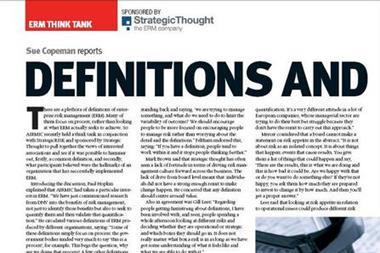Giovanni Gentile: It’s a nightmare when dealing with legal entities around the globe. which operate under different regulatory frameworks. If in addition you have to deal with accounting frameworks, ERM systems and Solvency systems, you will have to produce multiple set of statements. If as an industry, we are not successful in aligning these three and making them into one, it will be an even bigger nightmare. Traditionally, if you look at how much effort goes into having an auditable or SOXable accounting statement and you’re going to need the same number of people and amount of effort for the ERM system and Solvency system, it will be an enormous cost for the industry.
Olly Reeves: In terms of information, a great challenge that Lloyd’s faces is that we operate a platform for many businesses to operate in but we don’t own those businesses. So our ability to get granular detailed information is probably very different to that of a normal insurer. One of the questions that rating agents ask is: how can you manage the market effectively if you can’t go into an underwriting system and see every risk that has been written? Well, we just can’t do that so a big challenge is how we centrally, in terms of operating that platform, set out at the front limits to appetites, standards, control, frameworks, etc, and then how we monitor at the back-end. And there is this whole piece in the middle around how businesses operate day to day. So information and data generally are a massive challenge for us as we’re a decentralised organisation.
Sue Copeman: How can you measure, quantify the value of ERM?
Tom Wilson: The CRO has a pretty thankless job in the sense that, if you are in the equivalent of a bull market, you are seen as a constraint and then, if you are in the equivalent of a bear market, nobody counts the number of bullets you avoided, they only count the number of bullets that you take. So it is very difficult to actually establish the value. There have been a lot of different efforts to come up with various metrics but I haven’t found any of them very convincing or compelling. I think basically it is the confidence that the CEO and the executive board have in you in terms of supporting the business to take better decisions.
John Redmond: I agree. I don’t think you can measure or quantify the value of ERM, although you might be able to measure the effects of not having ERM by considering the forms of potential failure.
Ole Hesselager: There are many areas of management where it is very difficult to come up with metrics that give you precise measurement of performance and ERM is one of them. Having said that though, ERM is probably one of the areas where you have a better measurement compared to other management areas. We have Standard & Poor’s saying that the majority of their weight in future ratings will be put on their assessment of ERM environments. So we have someone writing reports on how we perform in respect of ERM. Maybe it’s not specific metrics but I think it gives a pretty good idea and a fairly good measurement.
John Redmond: Do we take that kind of thing too seriously? The fact that rating agencies have decided that ERM is a key metric means that everyone rushes to build something that may not address the critical issues for a particular organisation.
Tom Wilson: What’s the direct link between ERM and shareholder value creation? It’s tough to measure. I think you have just got to have confidence.
Ole Hesselager: Maybe we put too much emphasis on what S&P are saying but it’s just that at present they’re quite vocal in the ERM environment. In a couple of years, it may be another voice. Solvency II is going to do very much the same thing as S&P is forcing us to do now, so no doubt in one form or another ERM will be measured as well as any other management area. I think we have a challenge to come up with new ERM metrics to measure the performance.
Ferdia Byrne: But if you do it well and you communicate well on what you are doing with your stakeholders, you stand to benefit from it with a certain amount per share or whatever because you are going to be ahead of the pack. And you are going to overcome some of the doubts that rating agencies, analysts and investors might have about you. Eventually, good ERM is going to become normal good business practice and, rather than getting a benefit from it, you are going to get discounted or penalised in the future if you don’t do it well.
Jonathan Titman: It is difficult to quantify exactly the effectiveness of certain aspects of ERM. You need to look at both sides of the equation. If you think about the capital side, say reinsurance optimisation, you should be able to estimate the capital saving and the reduction in cost of capital. And on the other side, if you went to a full type of risk based pricing/portfolio optimisation approach for certain classes of business, I think you would certainly believe that you were getting more reward for the risk that you were taking. So on both sides of the equation you can directionally say you are adding value
Sue Copeman: Finally, perhaps we could look at the future role of capital markets in risk management.
Giovanni Gentile: If you look at an insurance or reinsurance company, basically all insurance liabilities are a certain type of debt, and the capital markets are very efficient in trading all kinds of debt except so far, other than in a very limited manner, insurance liabilities. It is only a question of time before there will be an enhanced amount of liabilities traded in the capital markets. That has several advantages. First, it means there is a new source of capital which can be tapped. Second, having trading in any instruments improves transparency and efficiency. Third and not least, you will actually get something like a market price for those risks. There would be considerable economic potential in having a much broader securitisation market with an almost unlimited amount of capital that can be tapped. It would also be beneficial for investors because they would get access to some specific risks which might assist in diversifying their investment portfolios.
Tom Wilson: I am not so sanguine about the future development of cat bonds. There are three reasons to do securitisations. One is regulatory arbitrage and, if the regulatory framework gets more in alignment with the economics, than that rationale disappears. At present you see a large amount of volume being done out of the US in terms of remediating the excess reserve requirements on Triple X and A Triple X deals. They are purely for regulatory arbitrage, not for risk transfer. The second rationale is funding, often to support new growth. But a lot of companies can find other ways to support new business strain, for example out of earnings, so I don’t think funding is going to drive it. The third is risk transfer. Here you really have to ask the question – what is the role of an insurance company? I would distinguish between two roles of financial services. One is that of a bank which predominately intermediates transparent risks where the due diligence expenses are reasonably low. Insurance companies do risk absorption of relatively non-transparent risks. That’s the whole reason for insurance – it is cheaper for society to absorb those risks than it is to intermediate because that way only one company does the due diligence. Until those risks become more transparent, intermediation won’t be a valuable strategy. When you securitise, someone has to do due diligence not only on the risk but also on the structure, and then you need a rating agency to come in and rate the structure. This means that it is a more costly economic proposition potentially for non-transparent risk categories.
Jonathan Titman: Having said that, the private equity firms and hedge funds who tend to be buyers and holders of cat bonds are not so worried about the lack of a secondary market at the moment.
Tom Wilson: Yes, but it won’t be as attractive as an issuer.
Giovanni Gentile: I would agree with you that transparency is definitely a driver for more securitisation, but I think all the developments of the last couple of years go in the direction of making certain risks much more transparent and probably those will be the risks first able to securitise. I am not saying that we will have everything securitised tomorrow, it will be a process, but the more benchmarks or market loss indices that are developed, the more you will have transparency about the risk and then the efficiency of the capital market can kick in.
Tom Wilson: If you remove moral hazard or adverse selection risk, you can start doing more deals.
Jonathan Titman: At the moment it is a win win for both sides. You have got investors, the private equity firms and the hedge funds, with lots of capital looking for a new home, and who want to diversify and achieve marginal returns above risk free rates. On the other hand, you have got the insurers who are faced with higher reinsurance rates, lack of capacity and recalibration of the cat models which means that they think they need to buy more. So you have got this congruence.
Tom Wilson: As a primary company though, it is typically cheaper for me to go for reinsurance than it is to go directly to the capital markets. By the time I introduce the investment bankers, the ratings agencies, the structuring fees and everything else, it is cheaper to go to a professional counterparty that going to do a public or private placemetn to a counterparty which is not in the business.
















